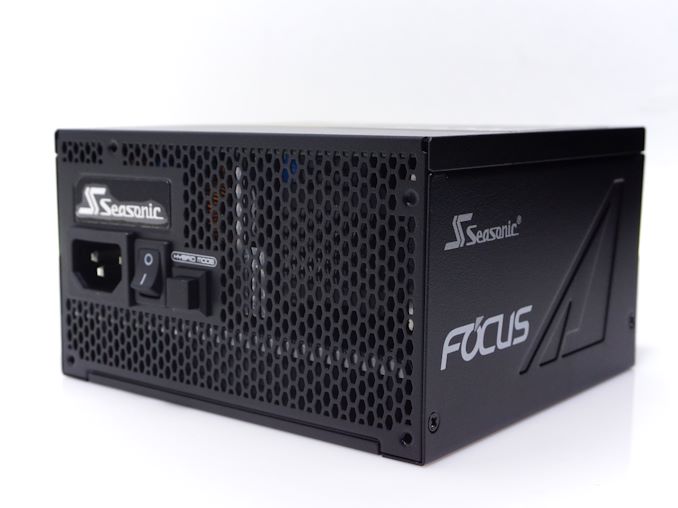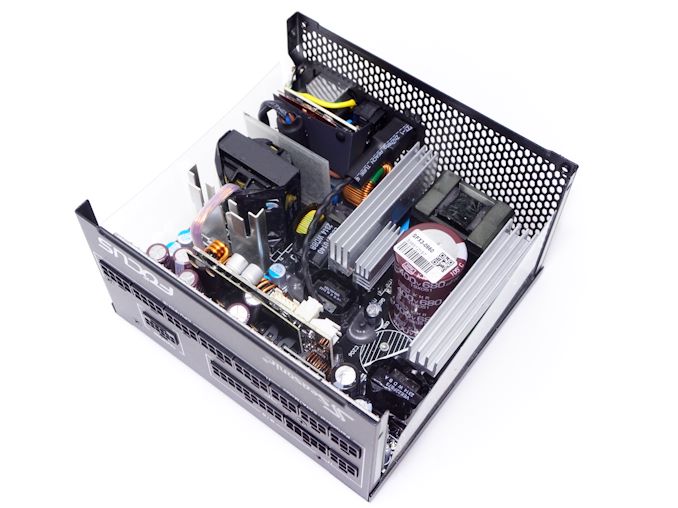The SeaSonic Focus GX-850 ATX 3.0 PSU Review: Cool, Quiet, and Robust
by E. Fylladitakis on November 29, 2023 8:00 AM EST- Posted in
- Cases/Cooling/PSUs
- Seasonic
- PSUs
- 80Plus Gold
- 850W
- ATX v3.0
- 12VHPWR
Power Supply Quality
As part of our testing, we also check output parameters are within specifications, as well as voltage ripple and line noise.
| Main Output | ||||||||
| Load (Watts) | 170.87 W | 426.55 W | 638.38 W | 850.33 W | ||||
| Load (Percent) | 20.1% | 50.18% | 75.1% | 100.04% | ||||
| Amperes | Volts | Amperes | Volts | Amperes | Volts | Amperes | Volts | |
| 3.3 V | 1.84 | 3.34 | 4.6 | 3.33 | 6.91 | 3.33 | 9.21 | 3.33 |
| 5 V | 1.84 | 5.04 | 4.6 | 5.04 | 6.91 | 5.02 | 9.21 | 5.01 |
| 12 V | 12.89 | 12.06 | 32.23 | 12.04 | 48.35 | 12.01 | 64.46 | 12 |
| Line | Regulation (20% to 100% load) |
Voltage Ripple (mV) | |||||
| 20% Load | 50% Load | 75% Load | 100% Load | CL1 12V |
CL2 3.3V + 5V |
||
| 3.3V | 0.4% | 16 | 14 | 18 | 20 | 14 | 18 |
| 5V | 0.45% | 14 | 16 | 16 | 22 | 18 | 20 |
| 12V | 0.5% | 20 | 20 | 24 | 28 | 26 | 22 |
The SeaSonic Focus GX-850 exhibits exemplary electrical performance metrics. It features tight voltage regulation on all three of its primary voltage rails (12V, 5V, and 3.3V), maintaining a regulation of less than 0.4%. The unit also boasts a low voltage ripple on the 12V rail, with a maximum recorded ripple of 28mV. In addition to this, the 3.3V and 5V rails demonstrate effective filtering, as indicated by a maximum voltage ripple of 22mV. These figures indicate a well-engineered electrical design that adheres to stringent performance criteria for a product of this class.
As part of our standard testing, we test the primary protections of all PSUs we review (Over Current, Over Voltage, Over Power, and Short Circuit). All of the protections of the SeaSonic Focus GX-850 engaged normally and within our expected parameters without any significant deviations.
Conclusion
The SeaSonic Focus GX-850 emerges as a robust ATX 3.0-compliant competitor in the crowded market of power supply units. Its build quality is exemplary, with an elegant exterior, custom embossed chassis decorations, and the convenience of fully modular cables. The internal components do not disappoint either, boasting high-grade Japanese capacitors throughout. The self-manufacture by SeaSonic ensures a meticulously designed unit, showcasing a redesigned Focus series platform aimed at ATX 3.0 compliance. The compact and clean design further accentuates its aesthetic and functional appeal while ensuring compatibility with all ATX-compliant cases.
Performance-wise, the Focus GX-850 excels in power quality. It exhibits remarkable voltage filtering, keeping the voltage ripples restrained below 28 mV even under strenuous loads. The load regulation is tight, with a variance of less than 0.5% on all voltage rails, showcasing its ability to deliver stable power under different load scenarios. Additionally, it comfortably meets the 80Plus Gold efficiency requirements, marginally missing the 80Plus Platinum certification at maximum load.
On the thermal front, the unit fares well with commendable thermal performance characterized by relatively low operating temperatures, a feature attributable to its high efficiency. Despite its substantial power output, the PSU maintains a cool operation, vital for long-term reliability and optimal performance. The noise level is another aspect where the Focus GX-850 shines; it operates nearly silently at low loads and room temperature. Although the noise level ascends with increased load, it remains within a tolerable range for most users.
The value proposition of the Focus GX-850 is somewhat nuanced. SeaSonic has undeniably elevated the performance metrics in the new Focus GX series over the preceding Focus Plus units. However, the current retail price of $168 positions it at a higher bracket compared to other 80Plus Gold certified ATX 3.0 units, never mind the $40 cheaper pre-ATX 3.0 version of the GX. The superior build quality and a reassuring 10-year warranty do provide some level of offset to the cost, but the heavy market competition due to a plethora of comparable products at or below its price point could pose a challenge for prospective buyers.
Ultimately, the SeaSonic Focus GX-850 ATX 3.0 is a formidable contender for those seeking a blend of quality, performance, and reliability, albeit at a premium price.












24 Comments
View All Comments
GeoffreyA - Wednesday, November 29, 2023 - link
It's beautiful.Techie2 - Wednesday, November 29, 2023 - link
This is another high quality PSU from Seasonic. They are the gold standard in PC PSUs IMNHO.HaninAT - Wednesday, November 29, 2023 - link
My only issue is that I just bought their prior generation Focus GX 850... Oh well... I will need the new fangled PCI-EX power lead eventually anyway.Samus - Wednesday, November 29, 2023 - link
This exact fan failed on my Seasonic Focus GX-700 after 2 years. It started making rattling noises, the shaft inside the hub rounded itself out of the bearing. Replacing it was a pain in the ass because the fan controller is calibrated for a specific amp fan, and if you use one thats rated over or under the stock fan, it will either spin faster or not spin at all, the later of which was my issue because I upgraded the fan to a beefier ball bearing NMB.Seasonic should get a clue and use ball bearing fans in PSU's they market as premium and charge top dollar for. A quick google search will reveal I am far from the only one with a Seasonic PSU fan failure, and while its under warranty, you will be without a PSU for 2 weeks during the RMA process as they do not offer advanced RMA, and the process itself is a frustrating social experiment I lost patience with and opted not to go through.
sonny73n - Wednesday, November 29, 2023 - link
I would just replace the fail fan with a case fan and connecti it to the motherboard. The silent/fan-stop feature is unnecessary because one more running fan would not make a different.Samus - Thursday, November 30, 2023 - link
If you don't have a fan connected to the PSU, the fan controller prevents the PSU from powering on because it thinks the fan is dead. You could put a resistor in to trick it, but then you are faced with a fan that is running independently of the PSU, disregarding its temperature zone. Sure, you could put a fan in that runs at full speed, it would be noisier than necessary. Or you could roll the dice and try running the fan based on case or CPU temperature which would theoretically scale with PSU load, but...all Seasonic needed to do to avoid ALL OF THIS BS is to put a reliable fan in their PSU's.I have a 15 year old PC Power & Cooling Silencer 750 that has way beyond 100,000 hours on it. Original fan, still silent.
liquid_c - Monday, December 18, 2023 - link
15 years equals ~129600 hours. You ran over 100.000 hours during this time? 11 and a half years of non-stop running? I find it hard to believe.bernstein - Wednesday, November 29, 2023 - link
Why do they still make those huge PSUs with those silly huge and ancient atx power plugs?I mean all it does is converting to 12V power… the rest is just useless 5v/3v stuff for long obsolete tech like 2.5” hdds…
bernstein - Wednesday, November 29, 2023 - link
Also, who the hell still needs 10 sata, 3 molex & 1 floppy power plugs. Those things are ancient (well 3.5” hdds are still a thing but, still motherboards with more than 4 sata ports are getting rare…evanh - Thursday, November 30, 2023 - link
Dude, that's why it's modular. And can even cut off what you don't want.